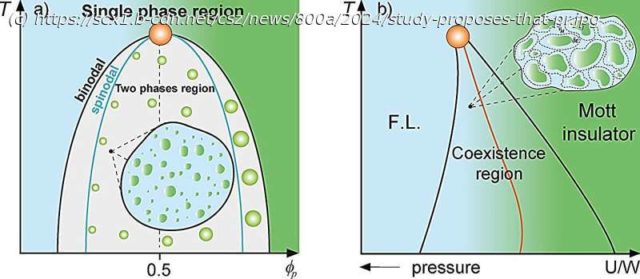In physics, a system composed of two substances can be modeled in accordance with classical mixture theory, which considers the fraction corresponding to each constituent and the interactions among constituents. Examples include the coexistence of high- and low-density phases in supercooled water, and the coexistence of metal puddles in an insulating matrix in the Mott metal-insulator transition.
In physics, a system composed of two substances can be modeled in accordance with classical mixture theory, which considers the fraction corresponding to each constituent and the interactions among constituents. Examples include the coexistence of high- and low-density phases in supercooled water, and the coexistence of metal puddles in an insulating matrix in the Mott metal-insulator transition.
Motivated by this kind of consideration, researchers at São Paulo State University (UNESP) in Rio Claro, Brazil, used concepts of condensed matter physics to describe protein compartmentalization in cells and proposed a cellular Griffiths-like phase in direct analogy to the canonical magnetic Griffiths phase.
The study is published in the journal Heliyon. The last author and PI is Mariano de Souza, a professor at the Institute of Geosciences and Exact Sciences (IGCE-UNESP), and the first author is Lucas Squillante, a Ph.D. candidate at the same university.
“In the magnetic Griffiths phase, magnetized or non-magnetized regions emerge in paramagnetic or ferromagnetic matrices respectively, giving rise to a significant reduction in the dynamics of the systems. These so-called ‘rare regions’ emerge in random fashion. In previous work, we explored the electronic Griffiths-like phase at the verge of the Mott metal-insulator transition.
Home
United States
USA — IT Study proposes that proteins can compartmentalize and form droplets inside cells






